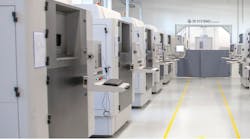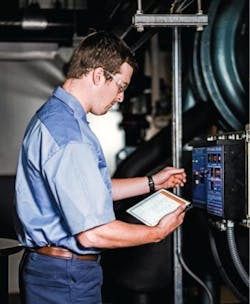In the restaurant business, the old adage, “sell the sizzle, not the steak,” emphasizes the importance of selling customer experience when there may not be a significance between the meals on offer. Meanwhile, restaurants also must focus on maximizing efficiency and profits with technology such as point-of-sale systems to turn tables quickly.
It’s a phenomenon becoming more applicable to industrial enterprises that deal with other businesses rather than end consumers. A key item left to sell is service, and innovation to make their products—and the customer’s experience of them—more effective, efficient and profitable.
The toolset of field service technicians and engineers now requires competency beyond traditional trades, including mastery of field service management (FSM) software systems that can bridge the gaps among employees in a hybrid labor force, as well as among customers and suppliers who benefit from shared data for analytics, remote monitoring and uptime optimization.
“Service is becoming the leading candidate of things that companies will bet the ranch on,” said Neil Barua, CEO of software-as-a-service (SaaS) field service solution provider ServiceMax, speaking in October at his firm’s annual user conference in Chicago. “And why is that the case? Economic slowdown is happening across the world…big companies that produce products are looking for things that can weather the storm.” And that’s why he believes service is becoming the actual “product” for many industrial organizations.
Along with the manufacturing downturn, new customer growth is slowing, and therefore, “repeatable business and recurring revenue is crucial to industry,” Stacey Epstein, ServiceMax CMO and customer experience manager, told Smart Industry. “And really, the part of the business that is most likely to turn into a recurring revenue stream is service.”
The company, newly independent after two years of ownership by a restructuring GE, is experiencing growth in asset-intensive industries, and expects to equip its customers for competitiveness with a new-generation of field service tools for digital transformation.
WORKFORCE CHALLENGES
One of the greatest challenges that industrial firms face is a paucity of skilled labor. According to IDC’s 2019 Worldwide Manufacturing Talent Management survey, between 26% and 31% of respondents’ top pressures relating to workforce include:
• Finding people who fit with the company’s growth objectives (i.e., geographic growth, expansion initiatives);
• Dealing with a lack of skills required for digital transformation; and,
• Having a workforce that can help meet their company’s speed-to-market goals and/or competitive pressures.
Specifically relating to field service, IDC further reports that manufacturers are grappling with how to manage contractors, how to get such thirdparty employees to work effectively with in-house teams in a hybrid work environment, and how to train up employees on the new technology that will help them provide seamless, “connected” services. More than half (51.1%) cited a lack of in-house resources, and a third (33.8%) said their employees lack the skills/knowledge to perform as required.
Related research by the TSIA, the Technology Services Industry Association, notes that companies seeking to outsource asset maintenance want those suppliers to have some “skin in the game” by sharing some risk and responsibility with the asset owner. “As a result, the supplier now has to play an active role in optimizing the customer’s actual outcome, which means that the field services organization needs to fully embrace a different set of skills,” TSIA says in its report, The State of Field Services 2019.
The toolset of field service technicians and engineers now requires competency beyond traditional trades, including mastery of field service management (FSM) software systems. Deployed across collaborative IoT networks, these systems can bridge the gap not only between employees in a mixed, or hybrid labor force but among customers and suppliers who benefit from shared data for analytics, remote monitoring and diagnostics, and uptime optimization.
SMARTER COLLABORATION
The FSM space has traditionally focused on maintenance work order processing: getting the right technician with the right parts to the right customer site at the right time. Over time and with the infusion of IT, the focus of FSM has shifted from work orders to what ServiceMax calls an “asset-centric” approach: using IT to create detailed records that provide service technicians with everything they need to know about the equipment and systems they’re servicing.
“Innovation is transforming the way that we view service,” adds Aly Pinder, program director for service innovation and connected products for IDC. A follower and staunch advocate of the technology-connected hybrid workforce, Pinder views innovation “through the lens of our ability to deliver on customer need, but also to turn a profit. And I think that’s going to change the world of the technician.” How? Ultimately, through IT-enabled customer selfservice, self-healing assets, virtual repairs and augmented reality (AR) assisted field service.
Consider this conversation between a technician and his dispatch hotline:
Technician: “When’s my next job?”
Dispatch: “Your next job comes in 1.5 hours at 2PM. It will take you about 45 minutes travel time, and you have 30 minutes left for this job. Is that enough time?”
Technician: “Uhh…it might be…”
Dispatch: Would you like me to notify scheduling that you may be running late?
Technician: Yes.
Dispatch: How much additional time do you need?
Technician: Probably about 30 minutes.
Dispatch: Ok, I have created a request to the dispatch hotline to extend this job for 30 minutes.
In this live-demo example, the technician was an onstage presenter at the ServiceMax event, and the dispatch hotline was actually an AI implementation of a natural-language interface (think Alexa or Siri) connected to the service system’s real-time database.
Elsewhere, AI is used to do “remote triage” virtually and at customer sites. Take the example of a technician who encounters an unfamiliar error code: To save time over calling or texting, the tech sends a message to the AI dispatch hotline. The system mines the database for previous interactions of this nature, and immediately—much faster than texting or calling a human being—delivers relevant information and suggestions. If a problem comes up that’s not in the database, the system lets the technician automatically connect to a live expert via text, voice or live video.
USE CASE: 3D SYSTEMS
“Our whole goal is to maximize uptime for the customer,” says Mark Hessinger, vice president of global customer services for 3D Systems. An early pioneer in commercial-scale additive manufacturing, the company, with 2018 revenues of $688 million and 2,500 employees, has a core focus on making, installing and servicing full-scale production systems at customer manufacturing sites, where it claims its technology can now rival the throughput and economics of traditional injection molding lines.
3D Systems builds, installs and maintains additive-manufacturing systems, as well as producing parts on-demand for customers from plants including this advanced-manufacturing facility in Pinerolo, Italy.
The company now has more than a year of experience using ServiceMax “service execution management” system, integrated with its IoT, to offer accurate remote diagnoses and more effective customer service.
The company’s IoT network, now standardized on AWS, is linked to its service organization, its customers’ production systems, as well as with the Salesforce-based ServiceMax system.
In 3D Systems’ connected environment, when a printer at a customer site veers from its product parameters, the system automatically creates a work order in ServiceMax. “The advantage of having a printer tell us ‘take a look at me,’ instead of ‘fix me’ is that we can get ahead of potential issues before they become problems.”
Citing one example of what he says are many, Hessinger says that at one customer facility, an event triggered a work order when the temperature in a printer’s melt chamber trended out of range. The event triggered an alert to a remote 3D Systems tech-support engineer, who interrogated the customer’s production system. The fix was simple: “By having the system telling us the process was drifting out of range, we were able to be proactive, and save the customer days of lost product and costly production downtime,” Hessinger says.
Hessinger cites a few significant benefits from his organization’s use of the system. First, his users in the field report that it has cut the time it takes for them to perform administrative tasks by 50 to 75%, so his field service organization operates more productively. Secondly, when technicians perform work at customer sites, they work smarter with more accessible and actionable AIassisted software functions for more efficient triage and call productivity. Additionally, his technicians have been elevated to become customer experience ambassadors who do more comprehensive service call debriefs on the spot, with less need for follow-up. Finally, with greater knowledge at their fingertips, technicians more routinely recommend additional assets the customer may want to put under contract to achieve greater plant uptime.
Ultimately, Hessinger says his field service personnel, backed by the new IT service infrastructure “are definitely helping us grow revenue.”
Similarly, a manager from a medical device manufacturer at the Chicago meeting explained that his service department isn’t just “servicing our customers, but also providing a service to the rest of our organization.” The company has pulled together data from his service database, SAP and other areas of the company’s IT network. He believes this may be a potential benefit to R&D and manufacturing: If analytics detects a preponderance of service issues with a particular part or sub-assembly, it can speed design improvements or optimized processes. Everybody wins, and the business profits.
The relationship between products, technology and people has been evolving for as long as there has been competition. More than a century ago, Gillette gave away razor blade handles to sell the blades. In 1962, Rolls-Royce pioneered the concept of “selling uptime” with the introduction of its Power-by-the-Hour service that charged aviation firms for flying hours, not jet engines—GE, Pratt & Whitney and the industry followed suit. Similar discussions may lead more companies to sell tires by the mile to trucking companies, laboratory tests instead of equipment and other activities that are at the heart of added value in the new industrial service economy.
By Bob Sperber






